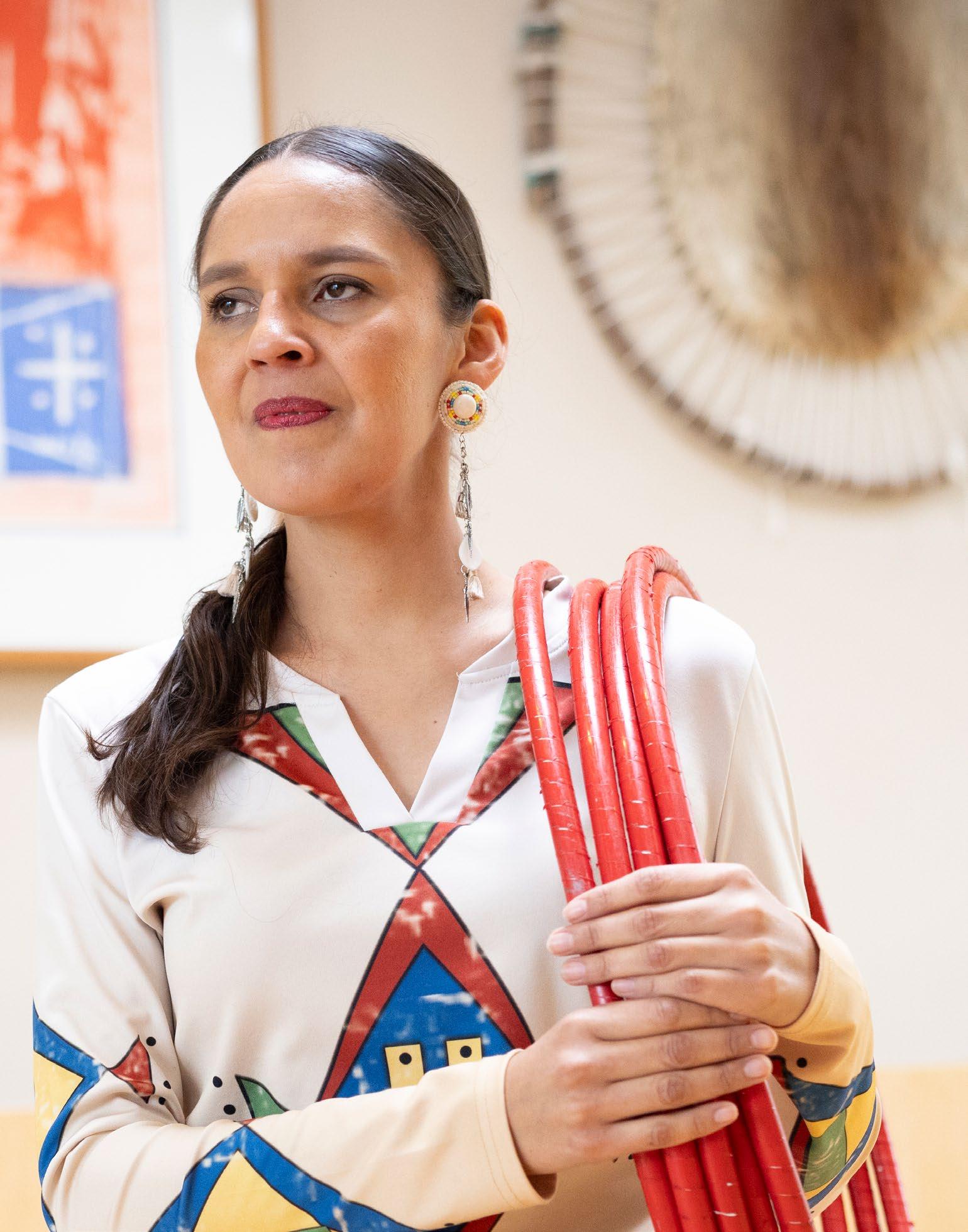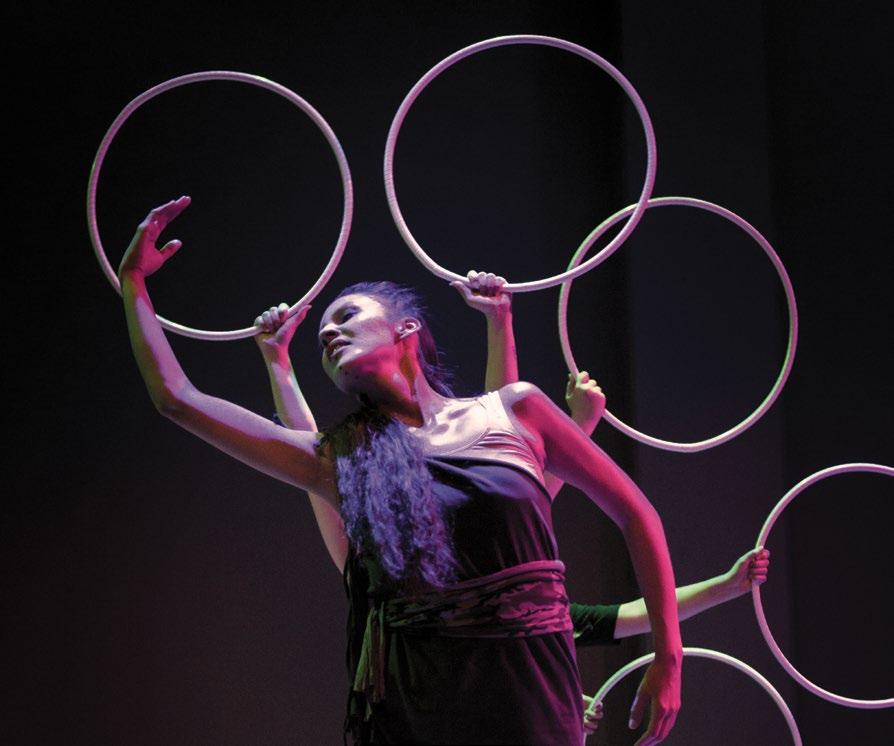
7 minute read
FROM TAP SHOES TO JINGLE DRESSES
A Journey of Cultural Rediscovery through Indigenous Dance
Sandra Lamouche ’08 found her home at Trent’s Nozhem First Peoples’ Performance Space and became an award-winning global ambassador for Indigenous arts and education.
From the ballet studios of Alberta to Trent University’s unique Indigenous performance space, Sandra Lamouche ’08 (Traill College) has been on a lifelong journey of cultural rediscovery and artistic achievement. Growing up in Alberta, Sandra recalls loving tap dance and ballet classes as a child, unaware that her Cree heritage also offered rich and meaningful dance traditions.
It wasn’t until high school, she says, that she saw an Indigenous dance performance that ignited a powerful instinct to express herself, tell stories, and share important history lessons through Indigenous dance and song.
After becoming a dancer and learning more about Indigenous history and culture, she decided to pursue Indigenous studies at the graduate level and says Trent University was a natural choice. The University is home to Nozhem: First Peoples’ Performance Space—the only publicly funded, dedicated Indigenous performance space in Canada. During her master’s program at Trent, Sandra immersed herself in Indigenous culture and history by watching and participating in myriad performances including hoop dancing and Jingle Dress Dance. She also became lifelong friends, as well as colleagues, with many Indigenous artists who performed at Nozhem.
“Nozhem helped me find that sense of community as an Indigenous artist that I didn’t feel like I had before, and it really became a home away from home,” says Sandra, Nehiyaw Iskwew of Bigstone Cree Nation in Alberta.
Sandra went on to become an internationally recognized multidisciplinary artist, educator and advocate. Her accolades include being a champion hoop dancer, an awardwinning children’s book author, and a respected Indigenous education leader, known for her efforts to integrate Indigenous Knowledge and practices into educational settings.
Sandra continues to perform dance across the world and recently returned to Trent for the world premiere of Out of Wounds—a contemporary dance that she created and performed at Nozhem in early November. While back at the University, she sat down with TRENT Magazine to discuss her life growing up in Alberta, reconnecting with her Indigenous culture, and how Trent became the place that feels like home.
CHANGING LIFE GOALS
Sandra was born in High Prairie, Alberta, a member of Bigstone Cree Nation, and raised in a family who connected to their Cree culture through storytelling, hunting, fishing, and beadwork. “I grew up with a little Cree spoken in our home, but I am the first generation on my mom’s side where Cree is not my first language,” she explains.
She pursued her undergraduate studies out west in what was then called Native studies, intending to become a teacher, but changed her career plans after gaining a deeper understanding of the historical struggles and contemporary issues affecting Indigenous peoples in Canada.
“I changed my life goals to become an artist to share what I had learned about Indigenous culture and history with a broader audience,” she says.
When deciding where to pursue graduate studies, she was drawn to Trent because of Nozhem, but also because of the University’s reputation as a leader in Indigenous Studies, and the rich Anishnaabe history and culture of the local area.
“Trent is one of the oldest and most respected Indigenous Studies programs in Canada and I had been interested to learn more about hoop dance, which originates from Anishnaabe culture,” she says.
After arriving at Trent in fall 2008 to pursue her master’s in Indigenous Studies, Sandra was thrilled to be exposed to many Indigenous performances at Nozhem, including a Māori group from New Zealand that performed dance and theatre, and renowned Indigenous dancer/ choreographer Rosalie Jones, who is known for her performances and teachings about the Jingle Dress Dance, a traditional healing dance of the Anishnaabe people. “It was powerful and special that we also had the chance to make our own Jingle Dresses as a workshop,” she says.
Sandra also gained valuable professional work experience by collaborating with performers who came to Nozhem. She was hired to work with Dancing Earth, a renowned performance company, and participated in their shows across Canada and the US. Additionally, she performed in Nozhem alongside Yvonne Chartrand—a distinguished Métis choreographer, dancer, and national award-winning master Métis jigger.
Academically, Sandra was gaining knowledge and wisdom from her Trent professors, including Professor David Newhouse, chair of the Chanie Wenjack School for Indigenous Studies, whom she had admired long before joining the University. “His classes were very inspiring,” she says. “I particularly enjoyed when he taught different research methods through an Indigenous lens.”
Throughout her studies, the First Peoples House of Learning also offered many enriching activities including language learnings, storytelling events, and Elders Gatherings. One special memory is joining Indigenous singersongwriter Joseph Naytowhow in placing tobacco in the Otonabee River and saying a prayer before a performance at Nozhem.
“I learned so much at Trent about Indigenous culture, heritage, and perspectives in ways that are profoundly different from a lecture,” she says.
TRANSITIONING FROM STAGE TO PAGE
Another profound change in her life during that time was when she and her husband welcomed their first son who— only a year later—inspired her award-winning children’s book We Belong to the Drum. The book, which won the 2024 Colorado Library Early Literacy Bell Award and was short-listed for the 2024-25 First Nation Communities READ Award, is based on the true story of her son’s experience at a Peterborough daycare. He would sob every day after getting dropped off until his parents suggested bringing in powwow music and drum feathers to show the other children.

“The next morning, he was excited to go to daycare and never cried again!” she says. “The book tells that story of needing a sense of belonging and not changing who you are in order to fit in.”
She had been writing her thesis at the time on “Seeking a Good Life through Indigenous Dance,” exploring Indigenous dance as a social determinant of health and wellbeing. “My son’s experience reinforced that for me,” she adds.
Since graduating, Sandra and her husband have welcomed another son, and Sandra has gone on to work with public-school children as an Indigenous success coordinator in the Livingstone Range School Division in southern Alberta. For this work, she was awarded an Esquao Award in 2019 through the Institute for Advancement of Aboriginal Women. The Esquao Awards recognize and highlight the significant role Indigenous women hold in homes, communities, and in the building of Alberta.
Currently, Sandra resides in Fort Macleod, Alberta where she consults with national and international arts organizations. She is frequently invited to provide keynote addresses on Indigenous education matters to global educational conferences. Earlier this summer, she also taught a university credit course on Indigenous dance forms.
She isn’t sure what the future holds but is thankful for having followed her passion instead of taking advice, as a younger woman, to choose a career based on how much income she could earn.
Sandra’s return to Trent this fall for the world premiere of Out of Wounds was her first time back to Peterborough in a decade and an emotional homecoming that symbolized her journey of growth and cultural reconnection.
“Performing in a space where I learned so much feels like coming home,” she says, holding back tears. “This is one of the only places in the world that feels like that.”
NOZHEM BY THE NUMBERS
While Nozhem First Peoples’ Performance Space is a small black box theatre that seats 100 in the Enwayaang Building, more than 10,000 audience members have enjoyed its performances since opening in 2004. Many performances have been filmed/recorded and are available through an archive.
Did you know:
• More than 40 Indigenous works have been created in total at Nozhem
• 25 Indigenous languages have been included in performances
• Six performances have been entirely in Indigenous languages
• One co-production at Nozhem was invited to the Canada Dance Festival and filmed by the National Film Board of Canada





